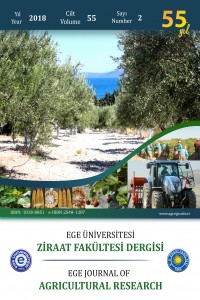İTHAL AYÇİÇEĞİ (Helianthus annuus L.) TOHUMLARINDA Plasmopara halstedii (Farl.)Berl. & De Toni)’ NİN VARLIĞININ MOLEKÜLER YÖNTEMLERLE ARAŞTIRILMASI
Abstract
Özellikle, tohum kaynaklı olan ve
tohumla taşınabilen etmenlerin hızlı tanılanması ve bunların kontrol altına
alınması sağlıklı bir ürün elde etmenin ilk aşamasını oluşturmaktadır. Bu çalışmanın amacı, ithalat
aşamasında analiz şartı olan tohum
kaynaklı Plasmopara halstedii (Farl.)
Berl. & De Toni)’nin ayçiçeği tohumundaki varlığının klasik yöntemlere göre
çok daha avantajlı moleküler yöntemler kullanılarak optimizasyonunun gerçekleştirilmesidir.
Klasik PCR (agaroz jel elektroforez) ile ilgili hesaplamaları EPPO Standart
Protokolleri Appendix 2 ve Real Time PCR (hidroliz probları) ile ilgili
hesaplamalar ise EPPO Standart Protokolleri Appendix 3 referans alınarak optimize
edilmiştir. Ayrıca, EPPO Standart Protokollerinde yer almayan Real time PCR
(SyberGreen) çalışmasında ise, SyberGreen Mastermix kit protokolü esas alınarak
optimize edilmiştir. Böylece, ülkemiz karantina laboratuarları içerisinde her
üç moleküler protokülün daha uygulanabilir olması sağlanmıştır. Ayrıca, bu
optimizasyon ile etmenin ayçiçeği tohumundan direkt tespitine yönelik ilk
moleküler çalışma da gerçekleştirilmiştir.
References
- Kaynaklar Berg T., Tesoriero L. and Hailstones D.L., 2005, PCR-based detection of Xanthomonas campestrispathovars in Brassica seed. Plant Pathology Volume 54, Issue 3 June 2005, 416–427pp.
- Bitki Karantinası Yönetmeliği, 2011, 03 Aralık 2011, Resmi Gazete Sayı: 28131.
- Bonants, P.J.M., Schoen, C., van der Wolf, J.M. and Zijlstra, C., 2001, Developments in detection of plant pathogens and other plant-related organisms: Detection in the past detection in the future. In: Proceedings of the 53th International Symposium of Crop Protection, Gent, Belgium, May 8th 2001. Mededelingen Faculteit Landbouwkundige en Toegepaste Biologische Wetenschap, Universiteit van Gent, 66: 25–37pp.
- Bouterige, S., Robert, R., Bouchara, J.P., Marot-Leblond, A., Molinero, V. and Senet, J.M., 2000, Production and characterization of two monoclonal antibodies specific for Plasmopara halstedii. Applied and Environmental Microbiology, 33 ref.66(8):3277-3282pp.
- Erkan, S., 1998, Tohum Patolojisi, EÜ Zir.Fak.Bitki Koruma Bölümü Doktora Programı Ders Kitabı 6-40s.
- Ioos, R., Laugustin, L., Rose, S., Tourvieille, J. and Tourvieille de Labrouhe, D, 2007, Development of a PCR test to detect the downy mildew causal agent Plasmopara halstedii in sunflower seeds. Plant Pathology 56, 209-218pp.
- Ioos, R. and Iancu, G., 2008, European collaborative studies for the validation of PCR-based detection tests targeting regulated fungi and oomycetes. Bulletin OEPP/EPPO (2008) Bulletin 38, 198–200pp.
- Ioos, R., Fourrier, C., Wilson, V., Webb, K., Jean-Luc Schereffer, and Tourvieille de Labrouhe, D, 2012, An optimized duplex real-time PCR tool for sensitive detection of the quarantine oomycete Plasmopara halstedii in sunflower seeds. Phytopathology 102:908-917pp.
- Innis, M.A. and Gelfand.,1990, Optimization of PCR’s in PCR Protocols. Academic, San Diego, CA, 3-12pp.
- Kahya, S., Buyukcangaz, E. ve Carlı, K.T., 2013, Polimeraz Zincir Reaksiyonu (PCR) Optimizasyonu. Uludag Univ. J. Fac. Vet. Med. 32 (2013), 1: 31-38. Moinard, J., Mestries, E. and Penaud, A., 2006, An overview of sunflower downy mildew. Phytoma – La Défense des Végétaux 589:34–38pp.
- Mullis, KB., 1990, The unusual origin of the polymerase chain reaction. Scientific American. 1990; 262(4):56–61. 64–5. [PubMed]
- Noble, M., 1957, The transmission of plant pathogens by seed In:Horton-Smith C. (ed.) Biological aspects of Transmission of Diseases Oliver & Body, Edinburg, UK, a,81-85pp
- Singleton, L., Mihail, J.D., Rush, C.M., 1992. Methods for Research on Soilborne Phytopathogenic Fungi, APS Press, St. Paul, MN.
- Zazzerini, A. and Raggi, V., 1974, Plasmopara helianthi in sunflower seeds, transmission of the disease and germination capacity of infected seeds. Sementi Elette 20(5):21-25. “alınmıştır” Review of Plant Pathology,1976. 55(2):150p.
Details
| Primary Language | Turkish |
|---|---|
| Subjects | Engineering |
| Journal Section | Articles |
| Authors | |
| Publication Date | June 27, 2018 |
| Submission Date | January 9, 2018 |
| Acceptance Date | February 6, 2018 |
| Published in Issue | Year 2018 Volume: 55 Issue: 2 |

